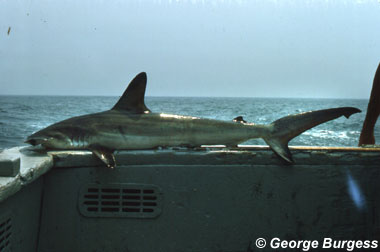
Sphyrna zygaena
This coastal shark prefers shallow waters, and are reported to even venture in freshwater. Sporting a wide and smooth cephalophoil or “hammerhead” this seasonal migrant is the second largest in the genus Sphyrna.
Order – Carcharhiniformes
Family – Sphyrnidae
Genus – Sphyrna
Species – zygaena
Common Names
- English: smooth hammerhead, common hammerhead, common smooth hammerhead round-headed hammerhead
- Afrikaans: gladde hamerkop
- Arabic: abou bornita, iskandar, jarjur
- Bikol: awal, tampugan
- Dutch: gladde hammerhai, hamerhaai
- German: Gemeiner Hammerfisch
- Greek: pateritza, and zygaena
- Finnish: vasarahai
- French: cagnole, marteau, requin marteau
- Italian: pesce martello
- Japanese: shiro-shumokuzame
- Kannada: variocha
- Marathi: boat
- Portuguese: cambeba, cornuda, martelo, pata
- Malay: yu palang
- Maltese: kurazza
- Spanish: cabeza de martillo, cachona, carnuda, corna, leunada, martell, martillo, pez martillo, sarda de cachas
- Swedish: hammerhaj
- Tagalog: balagbagan
- Visayan: kodosan
- Wolof: diarandoye
Importance to Humans
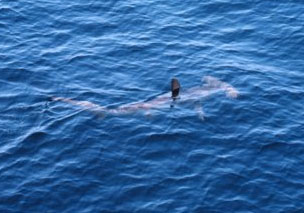
While edible, the meat is considered undesirable and not marketed. The liver oil is used in vitamins, hide for leather and carcasses for fishmeal. This shark has some of the highest-rated fins for the Asian shark fin soup market (Clarke et al., 2006).
Danger to Humans
Hammerheads are considered potentially dangerous. According to the International Shark Attack File, there have been 15 unprovoked attacks for all species of the genus Sphyrna, but no fatalities. Relatively few attacks have been attributed to this species due to its common occurrence in temperate rather than tropical waters where humans are more likely to enter the water.
Conservation
In the US, smooth hammerhead sharks are grouped with large coastal species, a group that biologists consider being most vulnerable to overfishing. The species is caught in gillnets, longlines, and as bycatch in driftnet fisheries. Due to their high fin ray count, they and other hammerheads are among the most desired species in the Asian shark fin market. S. zygaena, S. lewini, and S. mokarran have represented 5.9% of the fins auctioned in Hong Kong in past years (Clarke et al., 2006). The ICUN currently lists them as “Vulnerable”.
> Check the status of the smooth hammerhead at the IUCN website.
Geographical Distribution
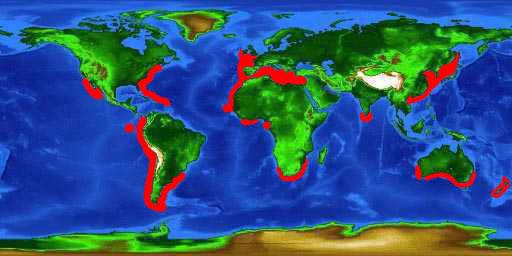
This species is found worldwide in temperate waters. In the western Atlantic Ocean, this species is found from Canada south to the Virgin Islands and from Brazil south to Argentina, while in the eastern Atlantic it occurs from the British Isles south to Côte d’Ivoire, including the Mediterranean Sea. In the western Indian Ocean, the smooth hammerhead occurs off the coasts of South Africa, India, and Sri Lanka. The distribution within the Pacific Ocean includes from Vietnam to Japan and Australia and New Zealand in the west, the Hawaiian Islands in the central region, and California (U.S.), Panama, and South America’s West coast (Compagno, 2005; Last and Stevens 1994).
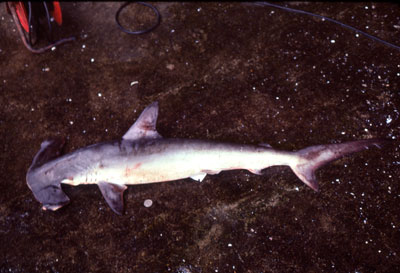
Habitat
Preferring shallow waters less than 20 m (65 ft.), smooth hammerheads lives close to shore over continental shelves and inshore waters such as bays and estuaries. However, this species has been reported in depths from 0-200 m (0-656 ft.) (Kotas, 2004; Vooren et al., 2005; Ebert, 2003). They occasionally venture into freshwater; Indian River, Florida, USA (G. Burgess pers. comm.) and in the Rio de la Plata estuary in Uruguay (Doño 2008). Juveniles form large aggregations, while adults occur individually or in small groups. The nursery habitats are generally smooth sandy substrate in shallow waters (10 m) (Bass et al. 1975). During summer months, smooth hammerheads form schools during migrations North to warmer waters and again during their return in winter (Ebert, 2003).
On occasion, the smooth hammerhead has been known to enter freshwater habitats including the Indian River along the coast of Florida (US).
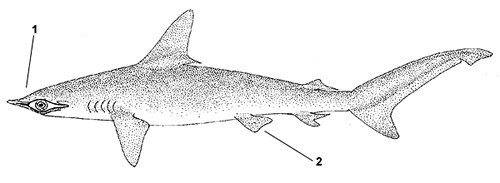
Distinguishing Characteristics
1. Head broadly arched and hammer-shaped and lacking an indentation at midline (“smooth”)
2. Pelvic fins with straight to nearly concave rear margins
Biology

Distinctive Features
The cephalophoil is broad and flattened with a rounded un-notched anterior margin. The head is indented opposite each nostril. The mouth is strongly arched. Pelvic fins are straight ending in nearly concave rear margins.
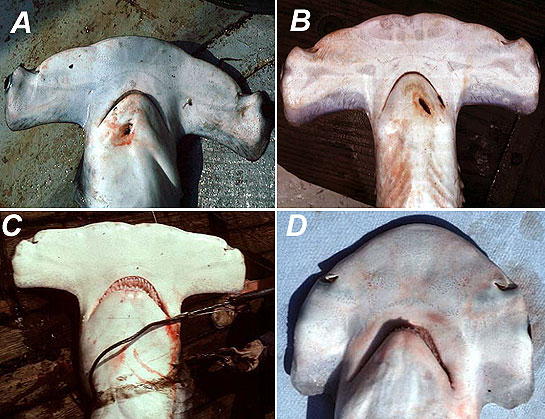
Within the hammerhead family, several species are differentiated from each other by variations within the cephalophoil. The great hammerhead (S. mokarran) is distinguished by its T-shaped head that has an almost straight front edge with a notched center. The scalloped hammerhead (S. lewini) is slightly smaller with a rounded anterior margin and notched head. The bonnethead (S. tiburo) is much easier to identify with a shovel-shaped head, and a much smaller size.
The smooth hammerhead’s back lacks a mid-dorsal ridge. The moderately tall first dorsal fin has a rounded apex and is falcate in shape with a free rear tip in front of the origin of the pelvic fins. The origin of this first dorsal is located over the pectoral fin insertions. The low second dorsal fin is shorter than the anal fin, with the free rear tip not extending to the precaudal pit. Pelvic fins are not falcate with straight or slightly concave posterior margins. The pectoral fins have only slightly falcate posterior margins. The anal fin has a deeply notched posterior margin.
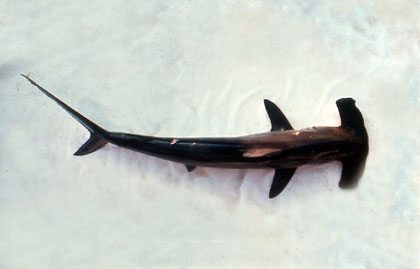
Coloration
Dark olive to brownish-gray in color with a white underside. This is in contrast to the brown coloration that is common to many other species of hammerheads. Some individuals have dusky or black-edged pectoral fins.
Dentition
There are 26-32 triangular, smooth-edged teeth in each side of the upper jaw and 25-30 smooth or weakly serrated teeth in the lower (Ebert, 2003).
Denticles
Denticles densely arranged with w-shaped posterior margins. Denticles are as broad as they are long with small specimens possessing three ridges extending from the center to the posterior edge, while large individuals have five to seven ridges extending about halfway back from the anterior margin and 3-5 teeth along the posterior margin with the middle one the longer than the others (Tanaka et al., 2002).
Size, Age, and Growth
Very little is known about the life history of the species still but believed to reach a maximum of 370-400 cm (12-13 ft.) (Compagno, 2005). Males mature at roughly 250-260 cm (8.2-8.5 ft.) and females at 265 cm (8.7 ft.) (Stevens, 1984). The species is believed to live 20 years or more, but this is not yet known (Casper, 2005).
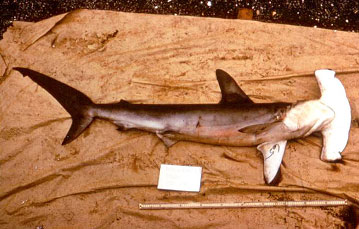
Food Habits
Feeding mainly on squid and boney fish, but crustaceans and smaller sharks and rays have been reported as well (Bass et al., 1975; Compagno, 1984; Stevens, 1984; Smale, 1991; Last and Stevens, 1994).
Reproduction
The species is viviparous with the eggs hatching inside the body and the embryos nourished by a yolk sac placenta. Parturition (giving birth) and mating happen during the spring, with females ovulating soon after giving birth (Bass et al., 1975; Stevens, 1984). 20-50 pups are born after a 10-11 month gestation period (Ebert, 2003; Stevens, 1984). Pups measure approximately 50-61 cm (20-24 in.) at birth (Compagno, 1984).
Predators
Larger sharks will prey on juveniles and sub-adults, however, adults have no major predators.
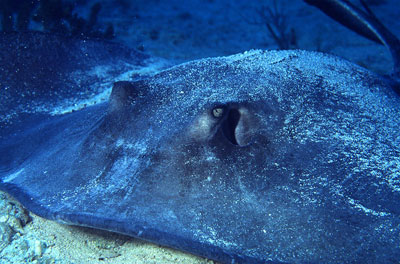
Parasites
The nematodes Parascarophis sphyrnae and Contracaecum sp. have been reported to parasitize the smooth hammerhead. As well as the copepod Kroyeria sphyrn (Dippenaar et al., 2001).
Taxonomy
The smooth hammerhead shark was originally described by Swedish natural historian Karl Linnaeus in 1758 as Squalus zygaena. This name was later changed to Sphyrna zygaena (Linnaeus 1758) which is currently the valid name. The name Sphyrna translates from Greek to the English language “hammer”, referring to the hammer-shaped head of this species. Linnaeus, considered the “Father of Taxonomy”, created the system of naming species that is still in use today. Synonyms referring to this species include Zygaena malleus Valenciennes 1822, Zygaena vulgaris Cloquet 1830, and Zygaena subarcuata Storer 1848.
There are approximately 10 related species of hammerheads throughout tropical and temperate regions including the bonnethead (Sphyrna tiburo), great hammerhead (Sphyrna mokarran), and scalloped hammerhead (Sphyrna lewini).
Revised by: Tyler Bowling 2019
Prepared by: Cathleen Bester
References
- Bass, A.J., D’Aubrey, J.D. and Kistnasamy, N. 1975. Sharks of the east coast of southern Africa. III. The families Carcharhinidae (excluding Mustelus and Carcharhinus) and Sphyrnidae. South African Association for Marine Biological Research. Oceanographic Research Institute. Investigational Reports.
- BIGELOW, H. B., AND W. C, SCHROEDER. 1948. Sharks, p. 59-576. In H. B. Bigelow and W. C. Schroeder (eds.). Fishes of the western North At- lantic, Part 1. Sears Found. Mar. Res. Mem. 1, Yale Univ., New Haven, Connecticut.
- Casper, B.M.; Domingo, A.; Gaibor, N.; Heupel, M.R.; Kotas, E.; Lamónaca, A.F.; Pérez-Jimenez, J.C.; Simpfendorfer, C.; Smith, W.D.; Stevens, J.D.; Soldo, A.; Vooren, C.M. 2005. Sphyrna zygaena Smooth Hammerhead. IUCN Red List of Threatened Species.
- Clarke, S.C., Magnussen, J.E., Abercrombie, D.L., McAllister, M.K. and Shivji, M.S. 2006. Identification of Shark Species Composition and Proportion in the Hong Kong Shark Fin Market Based on Molecular Genetics and Trade Records. Conservation Biology 20(1): 201-211
- Compagno, L.J.V. 2005. Sharks of the World. An annotated and illustrated catalogue of the shark species known to date. Volume 3: Carcharhiniformes. FAO, Rome.
- Dippenaar, S.M., Olivier, P.A. and Benz, G.W., 2001. Kroyeria sphyrnae Rangnekar, 1957 (Copepoda, Siphonostomatoida, Kroyeriidae): first description of the male, supplementary remarks on the female, A new geographic record for the species, and a key to Kroyeria males. Crustaceana, 74(9), pp.883-894.
- Doño, F. 2008. Identificación y caracterización de áreas de cría del tiburón Martillo (Sphyrna spp.) en las costas de Uruguay. Tesis de Licenciatura, Facultad de Ciencias, Universidad de la República de Uruguay.
- Ebert, D.A. 2003. Sharks, Rays, and Chimaeras of California. University of California Press. pp. 178–179. ISBN 0-520-23484-7.
- Kotas, J.E. 2004. Dinâmica de populações e pesca do tubarão-martelo Sphyrna lewini capturado no mar territorial e zona econômica exclusiva do sudeste-sul do Brasil. Ciênciias da engenharia ambienta. Escola de Engenharia de São Carlos. CRHEA – USP.
- Last, P.R. and Stevens, J.D. 2009. Sharks and Rays of Australia, 2nd edition. CSIRO, Melbourne, Australia.
- Smale, M.J. 1991. Occurrence and feeding of three shark species, Carcharhinus brachyurus, C. obscurus and Sphyrna zygaena, on the eastern cape coast of South Africa. South African Journal of Marine Science 11: 31–42.
- Southall, E.J. and Sims, D.W., 2008. A smooth hammerhead shark (Sphyrna zygaena) from south-west England. Marine Biodiversity Records, 1.
- Stevens, J.D. 1984. Biological observations on sharks caught by sports fishermen off New South Wales. Australian Journal of Marine and Freshwater Research 35: 573–590.
- Tanaka, S., Kitamura, T. and Nakano, H., 2002. Identification of shark species by SEM observation of denticle of shark fins. Collective Volume of Scientific Papers ICCAT, 54, pp.1386-1394.
- Vooren, C.M., Klippel, S. and Galina, A.B. 2005. Biologia e status conservação dos tubarão-martelo Sphyrna lewini e S. zygaena. In: C.M. Vooren and S. Klippel (eds), Ações para a conservação de tubarões e raias no sul do Brasil, pp. 97-112. Igaré, Porto Alegre.